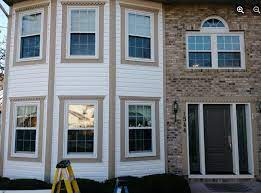Windows & doors enhance homes but have a functional lifespan of approximately 15-30 years before needing replacement. Gradual wear impairs efficiency and security over the years. Evaluating average lifespans helps homeowners identify the ideal time to replace fading fixtures.
Look for declining performance indications like loose frames, cloudy glass, high energy bills, exterior damage, and frequent repairs. Proactively replacing worn windows and doors restores air sealing, insulation, curb appeal, and peace of mind. Read on to understand the average lifespan of windows & doors and when to plan replacements. Unlike windows, exterior entry doors usually require replacement within 15-30 years due to material fatigue, seal failure, and deterioration after daily usage. Fiberglass and steel doors last longer than wood
- Standard Window Lifespans Range From 15-30 Years
Under regular use, windows typically last 15-30 years before requiring replacement. Build quality and materials determine lifespan. Well-built units maintain function beyond 30 years in ideal conditions.
Exterior seals, hinges, and glass units begin deteriorating with average use after 10-15 years. Ongoing paint touch-ups and maintenance prolong lifespan moderately, but replacement is inevitable.
- Harsh Environments Shorten Lifespan To 10-20 Years
Windows & doors in extreme climates or facing direct sunlight and precipitation deteriorate quicker – often within 10-20 years. Ultraviolet rays damage materials prematurely.
Sustained moisture exposure causes wood rot, mould, and frame warping. Coastal salt air is incredibly corrosive. Windows in hot, humid, and windy placements see reduced lifespans from harsh exposure.
- Careless Handling Causes Early Preventable Wear
How homeowners operate and clean windows also impact lifespan. Frequent slamming strains hinges while forcing stuck windows to break seals and hardware.
Harsh cleaning chemicals also erode window finishes, and cloud glass and degrade water-repellent coatings quicker. Improper paint application leads to early finish peeling. Avoiding preventable damage extends window lifespans.
- Typical Entry Door Lifespans Are 15-30 Years Too
Unlike windows, exterior entry doors usually require replacement within 15-30 years due to material fatigue, seal failure, and deterioration after daily usage. Fiberglass and steel doors last longer than wood.
Expanding gaps around the edges, warping, splintering, colour fading, and antiquated aesthetics indicate a door is due for a replacement to maintain security, insulation, and appeal.
- Interior Doors Have A Longer 50-year lifespan.
Interior doors endure far less weathering and wear from regular use, so the average lifespan reaches 50+ years. However, hinge hardware still requires periodic adjustment or replacement over time.
Splitting wood panels, sticking operation, and loose hinges signal age. Some homeowners replace interior windows and doors earlier for aesthetic reasons as styles evolve. But many originals remain functional for decades.
- Gradual Air Leakage Signals Replacement Time
As windows and doors Toronto age, air seals steadily deteriorate, allowing drafts, heat loss, and humidity infiltration. Monitoring your home’s internal climate and energy bills provides clues to developing air leakage.
If certain rooms feel drafty and energy costs rise despite maintaining the same usage, worn seals likely cause growing air infiltration, necessitating replacement. Restored tight sealing prevents wasted energy expenses.
- Condensation And Mold Signify Poor Sealing
Frequent condensation or mould growth near aging windows indicates substantial air leakage requiring replacement. If left unaddressed, this moisture penetration promotes gradual housing decay and potential mould hazards.
New, adequately sealed windows & doors effectively resolve condensation risks before significant water damage arises.
- Security And Safety Become Compromised
Loose, warped window frames allow easier forced entry over time. Damaged door locks also compromise home security eventually. Replacing dated fixtures restores safety and stability.
Likewise, old leaky ceiling skylights present falling hazard risks. Replace units exceeding 20+ years to maintain structural integrity and peace of mind.
- Fading And Cloudiness Means New Glass Is Due
Ultraviolet rays eventually cause the single-pane glass to fade and take on a cloudy tinge as coatings erode. Multiplane thermal seals also fail over time, fogging glass with condensation between panes. These all indicate replacement needs.
New glazing restores aesthetics and insulation performance. Upgrading to modern double/triple pane glass increases efficiency dramatically. Prioritize the foggiest and drafiest windows for the first replacement.
- Consider Restoring Historic Windows Properly
For cherished vintage or historic wooden windows facing deterioration after 50-100 years, specialized restoration experts can repair components and weatherize them to extend their usefulness without total replacements.
This preserves architectural heritage and charm sustainably. But restoration costs often approach replacement prices for far more significant efficiency gains. Seek contractors’ advice to weigh options.

